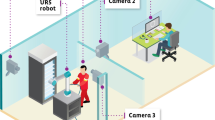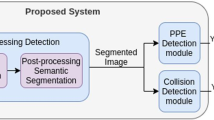Abstract
The increasing adoption of industrial robots to boost production efficiency is turning human-robot collaborative scenarios much more frequent. In this context, technical factory workers need to be safe at all times from collisions and prepare for emergencies and potential accidents. Another trend in industrial automation is the usage of machine learning techniques - specifically, deep learning algorithms - for image classification. Following these tendencies, this work evaluates the application of deep learning models to detect physical collision in human-robot interactions. Security camera images are used as the primary information source for intelligent collision detection. Unlike other proposed approaches in the literature that apply sensors like Light Detection And Ranging (LIDAR), Laser Range Finder (LRF), or torque sensors from robots, this work does not consider extra sensors, using only 2D cameras. Results show more than 99% of accuracy in the evaluated scenarios, revealing that approaches adopting deep learning algorithms could be promising for human-robot collision avoidance in industrial scenarios. The proposed models may support safety in industrial environments and reduce the impact of collision accidents.
Access this chapter
Tax calculation will be finalised at checkout
Purchases are for personal use only
Similar content being viewed by others
References
365 Microsoft Dynamics: 2019 manufacturing trends report (2019). Accessed 09 Sep 2019
Das, N., Yip, M.: Learning-based proxy collision detection for robot motion planning applications. arXiv preprint arXiv:1902.08164 (2019)
Deng, J., Dong, W., Socher, R., Li, L.J., Li, K., Fei-Fei, L.: ImageNet: a large-scale hierarchical image database. In: CVPR 2009 (2009)
Ferreira, J.L.C., Aloise, A.F., Matter, V.K., Barbosa, J.L.V., Rigo, S.J., de Oliveira, K.S.F.: A model for predicting disapproval of apprentices in distance education using decision tree. In: Proceedings of the XV Brazilian Symposium on Information Systems, SBSI 2019, Aracaju, Brazil, 20–24 May 2019, pp. 14:1–14:8 (2019). https://doi.org/10.1145/3330204.3330223
Gecks, T., Henrich, D.: Multi-camera collision detection allowing for object occlusions. In: 37th International Symposium on Robotics (ISR 2006)/4th German Conference on Robotics (Robotik 2006) (2006)
Henrich, D., Gecks, T.: Multi-camera collision detection between known and unknown objects. In: 2008 Second ACM/IEEE International Conference on Distributed Smart Cameras, pp. 1–10. IEEE (2008)
Howard, A.G., et al.: MobileNets: efficient convolutional neural networks for mobile vision applications. arXiv preprint arXiv:1704.04861 (2017)
Kingma, D.P., Ba, J.: Adam: a method for stochastic optimization. In: 3rd International Conference on Learning Representations, ICLR 2015, San Diego, CA, USA, 7–9 May 2015, Conference Track Proceedings (2015). http://arxiv.org/abs/1412.6980
Bureau of Labor Statistics: Employer-reported workplace injuries and illnesses -2017 (2018)
LeCun, Y., Bottou, L., Bengio, Y., Haffner, P., et al.: Gradient-based learning applied to document recognition. Proc. IEEE 86(11), 2278–2324 (1998)
Lee, S., Kim, M., Song, J.: Sensorless collision detection for safe human-robot collaboration. In: 2015 IEEE/RSJ International Conference on Intelligent Robots and Systems (IROS), pp. 2392–2397, September 2015. https://doi.org/10.1109/IROS.2015.7353701
Lee, S., Song, J.: Collision detection for safe human-robot cooperation of a redundant manipulator. In: 2014 14th International Conference on Control, Automation and Systems (ICCAS 2014), pp. 591–593, October 2014. https://doi.org/10.1109/ICCAS.2014.6987848
Pan, J., Chitta, S., Manocha, D.: Probabilistic collision detection between noisy point clouds using robust classification. In: Christensen, H.I., Khatib, O. (eds.) Robotics Research. STAR, vol. 100, pp. 77–94. Springer, Cham (2017). https://doi.org/10.1007/978-3-319-29363-9_5
Sharkawy, A.N., Aspragathos, N.: Human-robot collision detection based on neural networks. Int. J. Mech. Eng. Robot. Res 7(2), 150–157 (2018)
Sharkawy, A.-N., Koustoumpardis, P.N., Aspragathos, N.A.: Manipulator collision detection and collided link identification based on neural networks. In: Aspragathos, N.A., Koustoumpardis, P.N., Moulianitis, V.C. (eds.) RAAD 2018. MMS, vol. 67, pp. 3–12. Springer, Cham (2019). https://doi.org/10.1007/978-3-030-00232-9_1
Silva, I.R.R., Silva, G.S.L., Souza, R.G., Santos, W.P., Fagundes, R.A.A.: Model based on deep feature extraction for diagnosis of Alzheimer’s disease. In: Proceedings of the 2019 International Joint Conference on Neural Networks (IJCNN), vol. 1 (2019)
Simonyan, K., Zisserman, A.: Very deep convolutional networks for large-scale image recognition. In: 3rd International Conference on Learning Representations, ICLR 2015, San Diego, CA, USA, 7–9 May 2015, Conference Track Proceedings (2015). http://arxiv.org/abs/1409.1556
Takiguchi, T., Lee, J.H., Okamoto, S.: Collision avoidance algorithm using deep learning type artificial intelligence for a mobile robot. In: Proceedings of the International MultiConference of Engineers and Computer Scientists, vol. 1 (2018)
Acknowledgments
This work was supported by the Ericsson Research (Brazil), Conselho Nacional de Desenvolvimento Científico e Tecnológico (CNPq), Coordenação de Aperfeiçoamento de Pessoal de Nível Superior (CAPES), and the Fundação de Amparo a Ciência e Tecnologia de Pernambuco (FACEPE).
Author information
Authors and Affiliations
Corresponding author
Editor information
Editors and Affiliations
Rights and permissions
Copyright information
© 2020 Springer Nature Switzerland AG
About this paper
Cite this paper
Silva, I.R.R. et al. (2020). Assessing Deep Learning Models for Human-Robot Collaboration Collision Detection in Industrial Environments. In: Cerri, R., Prati, R.C. (eds) Intelligent Systems. BRACIS 2020. Lecture Notes in Computer Science(), vol 12319. Springer, Cham. https://doi.org/10.1007/978-3-030-61377-8_17
Download citation
DOI: https://doi.org/10.1007/978-3-030-61377-8_17
Published:
Publisher Name: Springer, Cham
Print ISBN: 978-3-030-61376-1
Online ISBN: 978-3-030-61377-8
eBook Packages: Computer ScienceComputer Science (R0)




